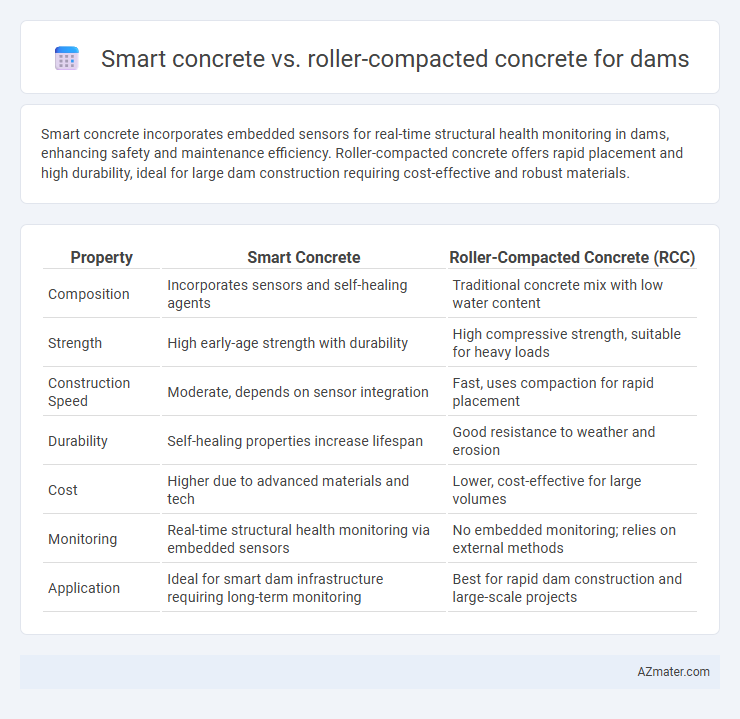Smart concrete incorporates embedded sensors for real-time structural health monitoring in dams, enhancing safety and maintenance efficiency. Roller-compacted concrete offers rapid placement and high durability, ideal for large dam construction requiring cost-effective and robust materials.
Table of Comparison
| Property | Smart Concrete | Roller-Compacted Concrete (RCC) |
|---|---|---|
| Composition | Incorporates sensors and self-healing agents | Traditional concrete mix with low water content |
| Strength | High early-age strength with durability | High compressive strength, suitable for heavy loads |
| Construction Speed | Moderate, depends on sensor integration | Fast, uses compaction for rapid placement |
| Durability | Self-healing properties increase lifespan | Good resistance to weather and erosion |
| Cost | Higher due to advanced materials and tech | Lower, cost-effective for large volumes |
| Monitoring | Real-time structural health monitoring via embedded sensors | No embedded monitoring; relies on external methods |
| Application | Ideal for smart dam infrastructure requiring long-term monitoring | Best for rapid dam construction and large-scale projects |
Introduction to Dam Construction Materials
Smart concrete integrates sensors and self-healing properties to enhance durability and monitor structural health in dam construction, offering real-time data and reducing maintenance costs. Roller-compacted concrete (RCC) is a cost-effective, high-strength material characterized by low cement content and rapid placement, widely used for large dam projects due to its excellent compressive strength and reduced construction time. Both materials address key challenges in dam construction, balancing performance, sustainability, and economic considerations.
Understanding Smart Concrete: Features and Benefits
Smart concrete incorporates embedded sensors and self-healing materials, providing real-time structural health monitoring and enhanced durability for dam construction. Its ability to detect strain, temperature, and moisture changes enables early detection of potential failures, significantly reducing maintenance costs and extending the dam's lifecycle. Compared to roller-compacted concrete, which offers rapid placement and high strength, smart concrete delivers superior adaptive performance through intelligent data integration and automated repair mechanisms.
Roller-Compacted Concrete: Key Characteristics
Roller-compacted concrete (RCC) for dams features a zero-slump consistency that enables rapid placement using earth-moving equipment and vibratory rollers, significantly reducing construction time and labor costs compared to traditional concrete. Its high-density compaction results in enhanced durability, low permeability, and resistance to freeze-thaw cycles, making it ideal for massive dam structures subjected to hydrostatic pressure. RCC's lower cement content and reduced water usage contribute to sustainability by minimizing carbon emissions, while its strong interlayer bonding ensures structural integrity and longevity in dam applications.
Performance Comparison: Durability and Strength
Smart concrete for dams offers enhanced durability through self-healing properties that repair micro-cracks, significantly extending the lifespan and reducing maintenance costs compared to conventional materials. Roller-compacted concrete (RCC) provides exceptional compressive strength and rapid construction capabilities due to its dry consistency and high-density compaction, but often requires supplementary measures for long-term crack control. The performance comparison highlights that smart concrete excels in durability under cyclic loading and environmental stress, while RCC prioritizes structural strength and cost-efficiency for large-scale dam construction.
Installation and Construction Methods
Smart concrete uses embedded sensors and self-sensing materials that enable real-time monitoring and adaptive curing during installation, enhancing structural health management. Roller-compacted concrete (RCC) involves placing and compacting a zero-slump mixture with heavy rollers, allowing rapid construction and reduced formwork requirements ideal for large dam bases. Installation of smart concrete demands precise integration of electronic components, while RCC requires efficient layering and compaction techniques to achieve optimal density and durability.
Cost Analysis: Smart Concrete vs Roller-Compacted Concrete
Smart concrete offers higher upfront costs due to embedded sensors and advanced materials, but it provides long-term savings through enhanced durability and real-time structural health monitoring, reducing maintenance expenses for dam projects. Roller-compacted concrete (RCC) generally incurs lower initial costs with faster placement and less formwork, making it cost-effective for large-scale dam construction. However, RCC may require more frequent inspections and repairs over time, potentially increasing lifecycle costs compared to the technology-integrated smart concrete.
Environmental Impact and Sustainability Considerations
Smart concrete integrates self-healing properties and embedded sensors that monitor structural health, reducing maintenance frequency and extending dam lifespan, which lowers overall environmental impact. Roller-compacted concrete (RCC) uses less water and cement compared to traditional methods, minimizing carbon emissions and resource consumption during dam construction. Both materials contribute to sustainability by enhancing durability and reducing the need for repairs, but smart concrete offers superior long-term environmental benefits through active damage detection and repair.
Maintenance and Longevity in Dam Applications
Smart concrete integrates self-healing materials and sensors that enable real-time monitoring and automatic crack repair, significantly reducing maintenance efforts and extending dam service life. Roller-compacted concrete offers high durability and rapid construction benefits but requires more frequent inspections and manual repairs, increasing long-term maintenance costs. The advanced durability and adaptive maintenance capabilities of smart concrete make it a superior choice for enhancing the longevity and safety of dam structures.
Case Studies: Real-World Dam Projects
Smart concrete has been effectively utilized in the Jinping-I Dam in China, where embedded sensors continuously monitor stress and temperature, enhancing structural health management. Roller-compacted concrete (RCC) was prominently used in the Upper Stillwater Dam in the United States, demonstrating rapid construction and cost efficiency without compromising strength. Case studies reveal smart concrete's superiority in providing real-time data for predictive maintenance, while RCC excels in large-scale dam construction requiring accelerated placing and compaction.
Choosing the Optimal Concrete Solution for Dams
Smart concrete enhances dam safety through embedded sensors that continuously monitor structural health, providing real-time data on stress and cracking. Roller-compacted concrete (RCC) offers rapid placement and high strength, making it cost-effective for large dam constructions with minimal curing time. Selecting between smart concrete and RCC depends on prioritizing either advanced monitoring capabilities for long-term maintenance or faster, economical construction without sacrificing durability.

Infographic: Smart concrete vs Roller-compacted concrete for Dam
 azmater.com
azmater.com